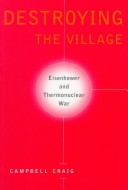In the early days of the Cold War, thermonuclear conflict was everywhere an imminent threat. With the realization that mutual destruction was the likely result of a nuclear war, US policy makers were forced to articulate a coherent stance on what they would do if the United States went to war with the USSR. The paradox of defeat or mutual annihilation was one that plagued American policy makers and scholars, whatever their stated position. Using declassified government documents from the early Cold War era, this text investigates what America's strategists really thought. It demonstrates that even as they were publicly attempting to make nuclear war technically feasible, many Pentagon officials and leading policy makers privately rejected the feasibility of any nuclear strategy. The author argues that by the late 1950s, the primary objective of the United States - though it was never voiced officially - was the avoidance of nuclear war. Craig examines the arguments Eisenhower had with his national security advisors, showing how he conspired to make the option of war with the Soviet Union impossible.
The book explains how Eisenhower clashed a number of times with hardened diplomats and military officials pushing for war, in meetings that the public did not know of. This book explores in detail the various superpower disputes over Berlin and the Taiwan straits, and over NATO and the Cuban missile crisis.
- ISBN10 0231111223
- ISBN13 9780231111225
- Publish Date 1 July 1998 (first published 1 June 1998)
- Publish Status Active
- Out of Print 18 January 2011
- Publish Country US
- Imprint Columbia University Press
- Format Hardcover
- Pages 234
- Language English
